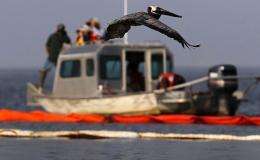Long odds on BP's desperate 'top kill' bid to plug oil leak (Update)

BP on Tuesday readied an ambitious plan to smother a ruptured underwater oil pipeline in heavy drilling fluid and cement, although company officials conceded that the "top kill" procedure has long odds for success.
BP's top officer downplayed the likelihood that the desperate effort will succeed in actually sealing the pipe, which is spewing hundreds of thousands of gallons of crude into the Gulf each day.
"It has never been done in 5,000 feet of water," the company's CEO Tony Hayward told reporters.
"If it was on land we would have a very high confidence of success, but because it's in 5,000 feet of water, we need to be realistic about the issues around operating in a mile of water," he said on Monday.
"We rate the probability of the success somewhere between 60 percent and 70 percent," Hayward said.
More than a month after it began, the oil spill has tarnished the Gulf of Mexico coast and sullied the reputation of the British energy giant, which has been unable to stench the underwater geyser which threatens to become the worst environmental disaster in US history.
Asked on US television Tuesday whether the Gulf spill is America's worst, Carol Browner, the top White House advisor on energy and environmental matters told ABC television, "I don't think there's any doubt, unfortunately."
The make-or-break top kill is supposed to get underway shortly after dawn on Wednesday using robotic submarines on the seabed. BP had hoped to try a top kill earlier, but needed more time to get equipment into place and test it.
"When the actual kill might go forward, the earliest might be tomorrow and that could extend on from there," BP executive vice president Kent Wells said, cautioning that "issues could crop up to delay that."
Even as they were keeping their fingers crossed that the top kill will succeed, officials were readying backup plans, although several might not be fully operational for several months, officials said.
BP's chief operating officer Doug Suttles said that if the top kill fails, relief wells are being drilled to divert the flow and allow the leaking well to be sealed. These will not be ready until August at the earliest however, meaning tens of millions more barrels of crude could stream into the Gulf.
BP engineers also are working on a "junk shot," which involves injecting assorted debris into the well to clog it up. Another backup plan would entail lowering a new blowout preventer -- a backup safety device -- on top of one that failed in an earlier attempt shut off the oil flow.
Louisiana Governor Bobby Jindal, meanwhile, has said he would like to build berms or islands that would provide an outer ring of protection to the coastline against oil advancing towards the state's coastline, but acknowledged that these also could not be put in place in less than six to nine months.
Meanwhile, political fallout from the massive oil spill mounted in Washington, with a new round of hearing into the growing disaster, which was spawned by an explosion on a BP-leased Deepwater Horizon rig on April 20, which killed 11 workers.
Fresh waves of crude oil continually sweep onto Gulf of Mexico shores, clogging fragile Louisiana wetlands, coating helpless sea birds in a layer of thick crude and wreaking havoc with the local economy despite on the Gulf for its livelihood.
There was growing frustration not only at BP's lack of success in capping the leak, but at the fact that federal officials also have proven powerless in shutting down the oil flow.
US Coast Guard chief Thad Allen, speaking to reporters at the White House Monday conceded that the US government lacked the expertise and equipment needed to stop the leak 5,000 feet (1,500 meters) under water, and defended BP's efforts so far.
"They're exhausting every technical means possible to deal with that leak," he insisted.
BP has intensified its PR offensive, taking out ads in major US newspapers and pledging up to 500 million dollars to study the impact of the spill.
Meanwhile, Hayward vowed to do everything possible to seal the leak and make residents of the soiled region whole.
"I feel devastated by that, absolutely gutted. What I can tell you is that we are here for the long haul. We are going to clean every drop of oil off the shore," the BP executive said.
(c) 2010 AFP



















